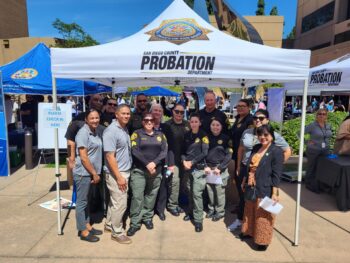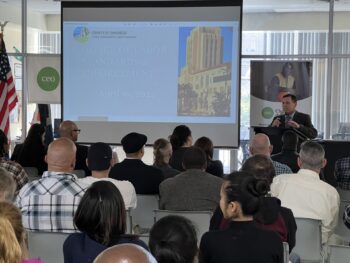A regional pilot program that has police and deputies from Oceanside to Chula Vista using the same technology to connect vandals to seemingly anonymous graffiti that mars utility boxes, trolley cars and buildings will continue for another year, County officials said recently.
The San Diego County Multi-Discipline Graffiti Abatement Program, which uses the Graffiti Tracker Web-based software to document and convict prolific vandals—even if they travel from city to city—started in January 2011 and had been set to expire June 30.
But the trial program has been extended one more year. SANDAG (the San Diego County Association of Governments), which documented and supported the pilot’s first phase, will continue to track its effectiveness, with an eye to making it a permanent program.
County Supervisor Greg Cox, who led the effort to create the regional pilot, said Graffiti Tracker is showing its worth after 18 months.
“Graffiti vandals are no longer getting away with defacing neighborhoods, degrading a community’s quality of life and sticking taxpayers with cleanup costs,” said Supervisor Cox. “Since law enforcement and prosecutors can pin dozens or even hundreds of acts on the person responsible, we are seeing significant increases in restitution orders.”
In the pilot program, the use of Graffiti Tracker expanded last year from three agencies to 13. Consequently, court-ordered restitutions for graffiti cases rose from $170,626 in 2010 to $783,412 in 2011, according to a recent SANDAG report. This represents a 579 percent increase in restitutions ordered for adult vandals and a 200 percent increase in restitutions ordered for juvenile vandals.
The County, cities and participating agencies split the 2011 cost of $346,800 to use Graffiti Tracker.
How it works
Graffiti Tracker is a commercial, Web-based program. Members of law enforcement or public works take pictures of graffiti with a GPS-enabled camera, and the photographs are uploaded to a database. Graffiti Tracker decodes the photographed “tags”—usually a vandal’s initials or nickname—and organizes them in a database. The location of identical tags can then be displayed on a map or a list, revealing patterns in place, time and frequency.
In 2011, some 288,000 cases were uploaded to the system.
When a tagger is caught in the act, a search of the database and the photos reveals similar marks, helping police and prosecutors link a person or a group to widespread tagging and damage.
Or, law enforcement can view a list of the top taggers in a city or region, look at the patterns of when and where the tagging occurred and use traditional investigative techniques to develop a suspect.
“You look at the worst ones, and you try to go find them, said Deputy District Attorney Victor Barr, who has been prosecuting Juvenile Graffiti Tracker cases for a few years. “We’ve had some huge successes; we’ve issued 200 counts on an individual.”
Catching roving taggers
Barr said that the pilot program has seen new jurisdictions learning how to work together to catch graffiti vandals.
Recently, young people caught marking a trolley car were caught by Metropolitan Transit System security. A check of Graffiti Tracker showed that the same kids probably damaged property in Chula Vista and National City, Barr said.
| Graffiti vandals will have no place to hide. We will catch them and they will be held responsible for all of the damage they caused. |
| -Undersheriff Ed Prendergast |
MTS and the two South County cities are among the new jurisdictions to try Graffiti Tracker. The other cities and agencies that adopted the technology as part of the pilot are Carlsbad, Coronado, El Cajon, La Mesa, the North County Transit District, the Port of San Diego, and the City of San Diego.
Barr said he thinks the program will be even more successful in 2012 than it was in 2011 as agencies grow familiar with the technology and the graffiti photo database is expanded.
In 2006, Escondido was the first jurisdiction to adopt Graffiti Tracker. Oceanside followed, and when the Sheriff’s Department joined in 2009, the ability of law enforcement to catch vandals who operated across jurisdictional boundaries along the Highway 78 corridor was quickly apparent, said Undersheriff Ed Prendergast, who headed the Sheriff Department’s effort to adopt the technology.
Prendergast said he’s confident the regionwide use of Graffiti Tracker will stop and deter taggers throughout the San Diego County.
“Graffiti vandals do not respect jurisdictional boundaries. Graffiti Tracker, in conjunction with a county-wide graffiti protocol, helps ensure that graffiti vandalism will be documented, investigated and prosecuted in a consistent manner,” Prendergast said. “Graffiti vandals will have no place to hide. We will catch them and they will be held responsible for all of the damage they caused.”
Or, he said, in short: “If you spray, you will pay!”
Serious consequences
According to the SANDAG report, about 74 percent of the graffiti entered in the database in 2011 was the work of taggers, 16 percent was gang related, and 10 percent was undetermined.
Taggers are usually young people who work in crews or alone to gain notoriety by making their mark as widely as they can.
Barr said many taggers seem addicted to the thrill, and some may believe themselves more mischievous than criminal. But when the court orders tens of thousands of dollars in restitution against a tagger—and holds juveniles’ parents responsible for paying—vandals may understand the seriousness of their hobby.
Senior Probation Officer Yvonne Salgado, who creates and reviews case plans with the families of juvenile offenders, said a recent case involving a teenager arrested for 68 counts of graffiti showed how seriously families take vandalism penalties.
The teen’s adult brother, a former tagger himself, may have known how prolific his brother was. But during a meeting with Salgado, the older brother was incredulous that police had found a way to link all the vandalism to the teen.
“The brother was shocked that there could be so many counts,” Salgado said.
The young offender’s parents said little in the meeting, apparently contemplating the more than $13,000 restitution order the family faced.
“The mom was appalled—she just seemed depressed about it,” Salgado said.
The probation officer said the trouble he’d caused his parents might make the teen think twice. Also, getting caught means the boy will be supervised by County Probation; its Breaking Cycles program for juveniles may help him make positive life changes and abandon tagging altogether, Salgado said.
“I’m optimistic this young man and his family will take advantage of the services Breaking Cycles offers, and they will have a meaningful impact that redirects his thinking and behavior,” she said.
Video: Sheriff’s Department works with Imperial Beach on Graffiti Tracker





